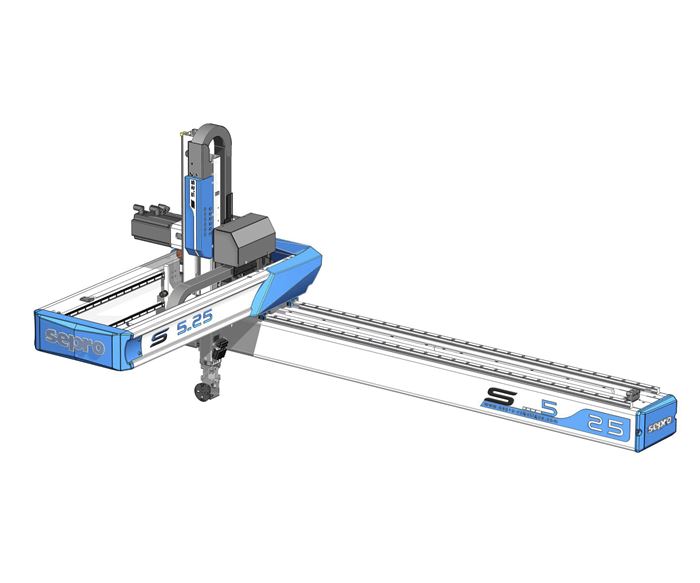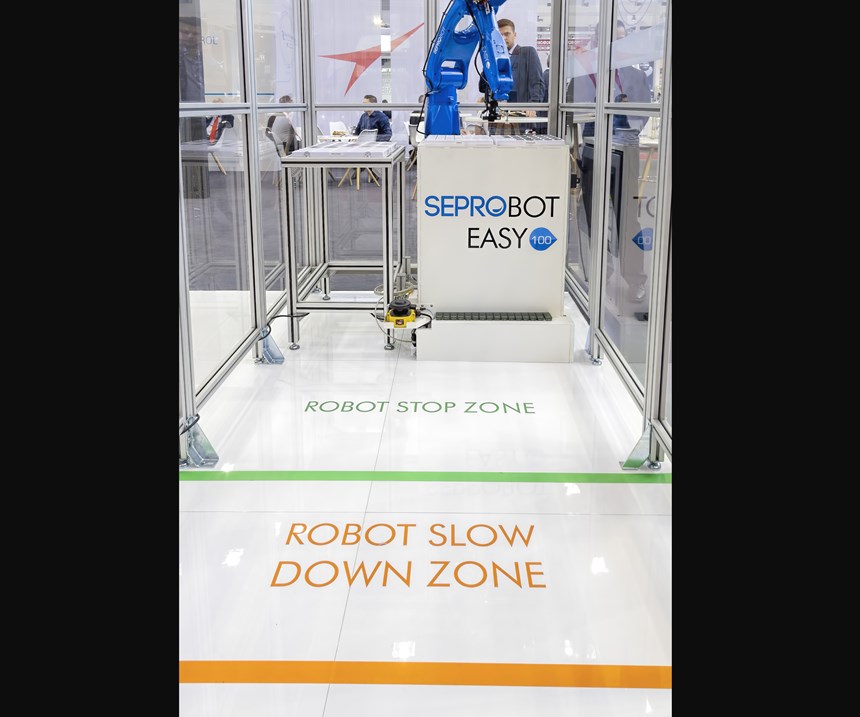Injection Molding: Faster Robots & Cobots
Sepro introduces S5-25 Speed Cartesian model and Seprobot collaborative solution for standard robots.
Two new robot developments from Sepro were shown at October’s Fakuma 2018 fair in Germany. Both involve increased speed for standard or collaborative automation.
The new Sepro S5-25 Speed three-axis Cartesian robot has a vertical (Z-axis) stroke speed that is 50% faster than the standard S5-25, allowing for robot in/out times under 1 sec and overall molding cycles under 4 sec. This speed is made possible by a more powerful, higher torque servomotor, plus upgraded electronics and pneumatic valves and lighter vertical telescoping arm.
This model was developed for Sumitomo (SHI) Demag, which offers it as the “Speed 7.” It is aimed at presses of 120 to 450 tons for simple packaging applications like flower pots, thin-wall food containers and tubs. It has a payload capacity (including tooling) of 7 kg, horizontal stroke of 1500 to 6000 mm, demolding stroke of 700 mm, and vertical stroke of 1200 mm. A smaller S5-15 Speed model was introduced two years ago, and a larger S5-35 Speed unit will be introduced at the K 2019 show this October. (Also coming in October is a new Visual 4 control for Sepro robots.)
The other new development from Sepro at Fakuma was the Seprobot, a “collaborative robot solution” designed to meet the requirements of most injection molding applications where limited human-robot collaboration is required and without sacrificing any of the speed or load-carrying ability of conventional three-, five- or six-axis robots. Typical collaborative robots, or cobots, are more limited in those respects. The company says the Seprobot is aimed at the 40% of injection molding applications in which human interaction with the robot is required only occasionally for removing finished parts or moving supplies or components into the robot’s operating zone.
Sepro’s solution for such cases is a physical enclosure with safe access for operators through openings protected by laser sensors, light curtains or other safety devices. (The accompany photo shoes a Yaskawa six-axis robot with a laser scanner.) Most of the time, the robot operates at full speed, slowing down or stopping only when sensors detect humans entering the guarded space, and returning to full speed automatically when they depart.
Related Content
-
A Cost Saving Modular Approach to Resin Drying Automation
Whether implementing a moisture-sensing closed-loop system for a single dryer, or automating an entire plant, technology is available to take the guesswork and worry out of resin drying. Using a modular approach allows processors to start simple and build more capabilities over time.
-
New Technology Enables ‘Smart Drying’ Based on Resin Moisture
The ‘DryerGenie’ marries drying technology and input moisture measurement with a goal to putting an end to drying based on time.
-
An Automation 'First' for Non-Servo-Eject Trim Presses
Compact, flexible and configurable robotic system is said to be the first to enable thermoformers to fully automate product handling after a non-servo trim press.

















